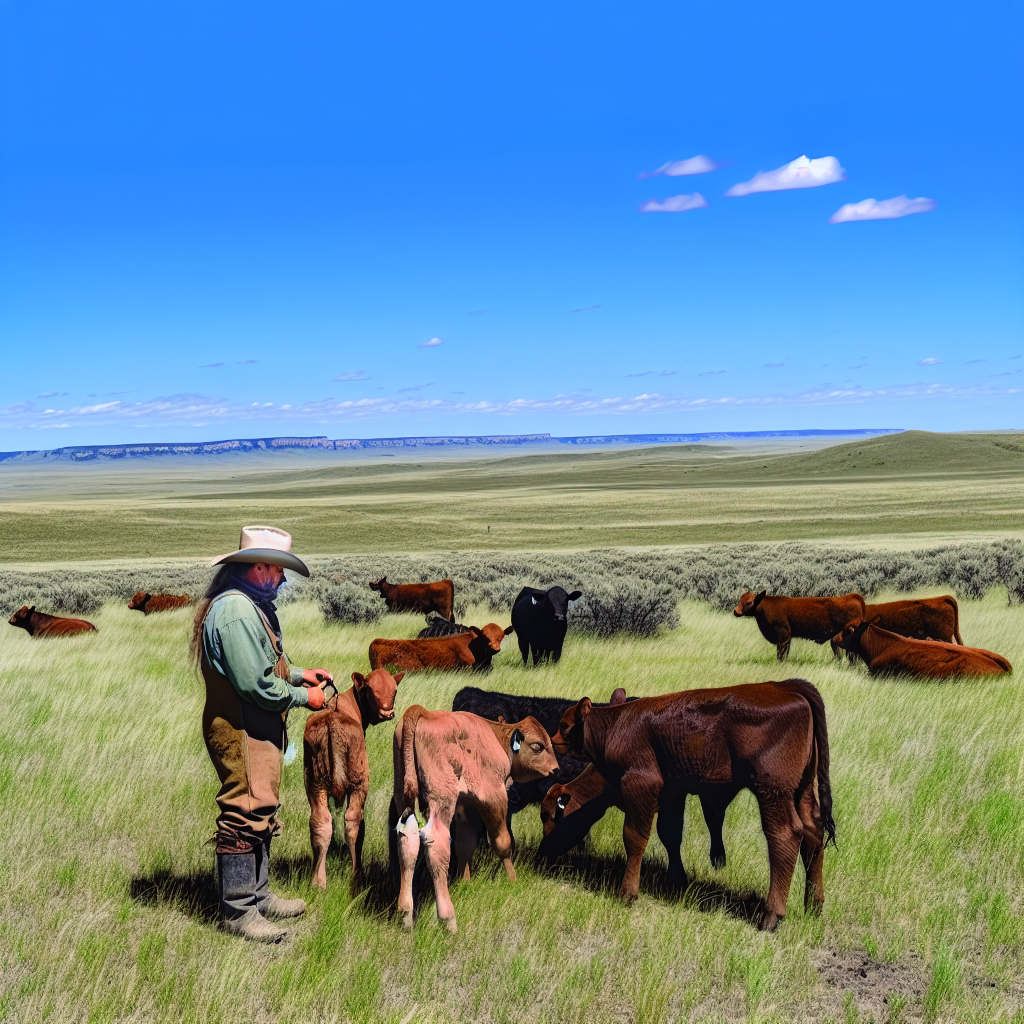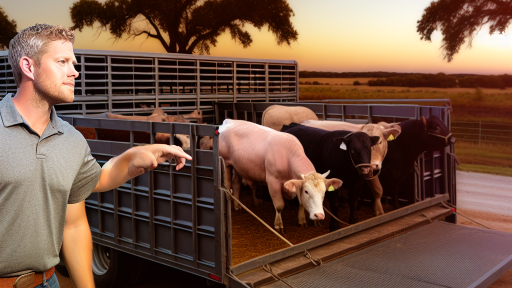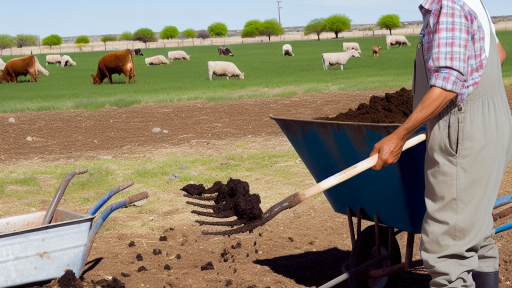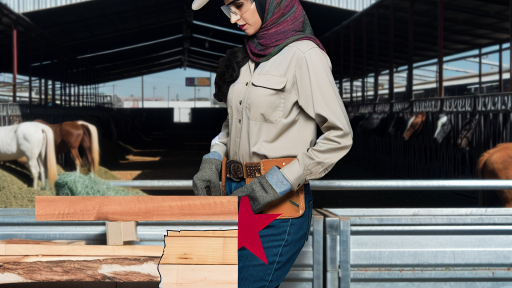Understanding the Beef Cattle Lifecycle
Key Stages from Birth to Market
The beef cattle lifecycle comprises several distinct stages.
Each stage plays a crucial role in overall production.
Understanding these stages can enhance management strategies.
Birth and Early Development
The lifecycle begins with the calf’s birth.
This stage lasts from birth until weaning, typically around six months.
Nutrition and health care are vital during this time.
Quality colostrum intake helps ensure a strong immune system.
Additionally, observing calf behaviors can indicate their health and needs.
Weaning to Backgrounding
After weaning, calves enter the backgrounding phase.
This phase lasts until the animals are around 12 to 18 months old.
During backgrounding, calves should gain weight efficiently.
Offering adequate nutrition is essential for optimal growth.
Regular health checks help prevent illness and support rapid growth.
Finishing Phase
The finishing phase prepares cattle for market.
This stage typically occurs between 12 to 24 months of age.
Transform Your Agribusiness
Unlock your farm's potential with expert advice tailored to your needs. Get actionable steps that drive real results.
Get StartedFeed efficiency becomes increasingly important during this time.
Providing a high-energy diet supports weight gain.
Monitoring body condition scores ensures cattle are market-ready.
Market Preparation
As cattle approach maturity, they require additional care.
Prior to market, a health evaluation is critical.
Scheduling vaccinations and health checks prepares cattle for sale.
Choosing the right marketing strategy impacts profitability.
Understanding market trends assists in making informed decisions.
Breeding Strategies
Importance of Genetic Selection
Selecting the right genetics leads to optimal growth rates in beef cattle.
Genetic traits directly impact efficiency and meat quality.
Understanding these traits can improve your herd’s overall productivity.
Evaluating Genetic Traits
Focus on traits such as growth rate and feed efficiency.
Look for animals with excellent carcass characteristics.
Mating decisions should prioritize these desirable traits.
Growth Rate
Growth rate is a critical performance indicator for beef cattle.
Faster growing animals reduce feed costs and improve profitability.
Feed Efficiency
Efficient feed conversion is vital for sustainable farming.
Genetics play a significant role in achieving enhanced feed efficiency.
Choosing Breeding Stock
Selecting breeding stock requires careful planning and assessment.
Evaluate potential breeders based on their genetic background.
Use performance data to inform your choices.
Health and Fertility
Healthy cattle are more likely to breed and raise high-quality offspring.
Prioritize animals known for both health and reproductive performance.
Crossbreeding Considerations
Crossbreeding can introduce new genetic diversity into your herd.
Showcase Your Farming Business
Publish your professional farming services profile on our blog for a one-time fee of $200 and reach a dedicated audience of farmers and agribusiness owners.
Publish Your ProfileIt often leads to hybrid vigor, enhancing growth and survival rates.
Using Technology in Genetic Selection
Modern technology enhances genetic evaluation processes.
DNA testing provides insights into the genetic makeup of cattle.
Use this data to make informed breeding decisions.
Data Analysis Software
Data analysis software can streamline the selection process.
Such tools help evaluate performance metrics quickly.
Long-Term Genetic Improvement
Genetic improvement is an ongoing process.
Monitor herd performance continually to make adjustments.
Stay informed about new genetic advancements and trends.
Nutrition Management
Formulating Diets for Different Growth Stages
Nutritional management is crucial for healthy beef cattle growth.
Each growth stage has specific dietary requirements.
These requirements depend on age, weight, and production goals.
Starting with calves, their diets must support rapid growth.
High-quality forage and creep feed are essential during this stage.
This diet encourages healthy weight gain and prepares them for weaning.
Weaning Diets
After weaning, dietary needs change significantly.
Transitioning to a balanced diet helps ensure optimal growth.
Include concentrates and high-quality forages in their feed.
This approach boosts energy intake and supports muscle development.
Regularly monitor their weight to adjust feed amounts as needed.
Growing and Finishing Diets
Growing cattle need diets rich in energy and protein.
Implementing high-grain diets can enhance growth rates.
Ensure that minerals and vitamins are part of their diet.
This supplementation supports overall health and reproduction.
Finishing diets need to focus on maximizing muscle gain.
Offer higher energy feeds to achieve optimal market weight.
Special Considerations
Different breeds may have unique dietary preferences and needs.
For instance, Angus cattle may require specific nutrient adjustments.
Caloric requirements also vary based on climate and season.
Monitor weather conditions to avoid stress-related health issues.
Consult with a livestock nutritionist for personalized diet plans.
Key Takeaways
- Nutrition management is vital throughout the beef cattle lifecycle.
- Adjust diets at each growth stage for optimal health and productivity.
- Monitor and modify feed as conditions and cattle evolve.
- Consult professionals to tailor specific nutritional needs.
See Related Content: Effective Strategies for Large-Scale Livestock Transport
Health Care Protocols: Vaccinations and Preventative Measures
Importance of Health Care Protocols
Health care protocols are crucial for maintaining beef cattle welfare.
They promote herd health and enhance productivity.
Implementing effective protocols helps prevent disease outbreaks.
Vaccination Schedule
Establishing a vaccination schedule is essential for every herd.
Calves should receive their first vaccinations within the first few months of life.
Core vaccinations typically include those for infectious bovine rhinotracheitis and bovine viral diarrhea.
Strategically schedule follow-up shots based on veterinarian recommendations.
Calf Vaccinations
Calves should begin with a combination vaccine between 3 to 6 months of age.
Showcase Your Farming Business
Publish your professional farming services profile on our blog for a one-time fee of $200 and reach a dedicated audience of farmers and agribusiness owners.
Publish Your ProfileThis vaccine protects against multiple diseases at once.
Adult Cattle Vaccinations
Adult cattle need annual vaccinations to maintain immunity.
This routine helps avoid outbreaks of preventable diseases.
Preventative Measures
Implementing preventative measures safeguards cattle health.
Regularly monitor herds for signs of illness or distress.
Provide clean water and high-quality feed to ensure optimal nutrition.
Biosecurity Practices
Establishing biosecurity measures prevents pathogen introduction.
Limit access to the herd and control visitor interactions.
Isolate new or sick animals to minimize disease spread.
Regular Health Checks
Routine health checks help detect issues early.
Veterinarians should conduct comprehensive examinations at least once a year.
Partnering with a veterinarian fosters proactive health management.
Record Keeping
Maintain accurate records of vaccinations and health interventions.
This documentation aids in tracking herd health trends over time.
Access to this data simplifies future health decisions.
Education and Training
Training staff on health protocols is imperative for success.
Educated personnel can quickly identify health issues.
Regular workshops help reinforce best practices within the farm.
Explore Further: Maintaining Cleanliness In Livestock Housing
Weaning Practices
Timing of Weaning
Weaning typically occurs between seven and nine months of age.
This timing aligns with the nutritional needs of both the calf and mother.
Consideration for local climate and pasture availability is essential.
Flexibility in timing can reduce stress on the animals.
For example, weaning during favorable weather can improve outcomes.
Techniques for Effective Weaning
Gradual weaning is highly effective in minimizing stress.
Utilizing gate separation allows calves to acclimatize slowly.
This technique fosters emotional stability in both cows and calves.
Additionally, offering supplemental feed helps calves transition.
Access to water must remain a priority throughout the process.
Environmental Considerations
Assessing the weaning environment can enhance cattle comfort.
Provide clean and dry shelter to protect against harsh elements.
Moreover, maintaining adequate space reduces competition stress.
A calm and familiar environment aids the adjustment process.
Monitoring Post-Weaning Behavior
Closely observe the calves following weaning.
This monitoring can help identify stress-related behaviors.
Signs like isolation or reduced feed intake require immediate attention.
Implement interventions quickly to support the calves’ well-being.
Regular health checks can prevent potential health issues.
Communication and Support
Engage with veterinarians for professional advice on weaning practices.
Participating in local farming groups can offer additional insights.
Showcase Your Farming Business
Publish your professional farming services profile on our blog for a one-time fee of $200 and reach a dedicated audience of farmers and agribusiness owners.
Publish Your ProfileSharing experiences helps gather diverse techniques for better outcomes.
Building a community around cattle management promotes knowledge sharing.
This connection enhances resilience among cattle ranchers.
Discover More: Sustainable Practices in Livestock Handling and Transport

Finishing Cattle: Feedlot Management and Growth Maximization
Introduction to Feedlot Management
Effective feedlot management maximizes cattle growth and meat quality.
A well-planned feedlot operation enhances profitability for producers.
This section explores essential management practices for feedlots.
Choosing the Right Feed Ingredients
Feed ingredients significantly impact cattle growth rates.
Producers should prioritize high-quality forages and grains.
Additionally, protein supplements can boost growth potential.
- Corn and barley are popular grain choices.
- Alfalfa and clover provide excellent forage options.
- Mixing feed can optimize nutritional value.
Implementing Nutritional Strategies
Nutritional strategies must align with cattle growth goals.
Regular assessments can help tailor diets effectively.
Consider incorporating additives to enhance feed efficiency.
- Probiotics improve gut health and digestion.
- Minerals and vitamins support overall health.
Monitoring Cattle Health
Health monitoring is crucial in a feedlot setting.
Regular veterinary check-ups ensure early disease detection.
Furthermore, proper vaccinations can prevent outbreaks.
- Administering respiratory vaccines is essential.
- Parasite control measures should be in place.
- Daily observation helps detect health issues promptly.
Optimizing Environmental Conditions
The environment plays a key role in cattle growth rates.
Ensuring proper ventilation helps prevent stress and illness.
Additionally, maintaining comfortable bedding promotes welfare.
- Clean and dry bedding reduces disease spread.
- Shading structures protect cattle from heat stress.
Implementing Efficient Feeding Practices
Efficient feeding practices enhance cattle productivity.
Scheduled feeding times can encourage uniform growth.
Utilizing automated systems can optimize labor efficiency.
Assessing Performance Metrics
Regular performance assessments guide management decisions.
Tracking average daily gain is fundamental for success.
Additionally, feed conversion ratios provide insights into efficiency.
- Maintain detailed records for optimal tracking.
- Use performance data to adjust management practices.
Preparing for Market
Market readiness is the final phase of feedlot management.
Producers should monitor market trends to maximize profits.
Optimizing carcass quality can enhance marketability.
- Ensure optimal weight and fat cover for beef quality.
- Consider timing sales according to market conditions.
Explore Further: Livestock Breeding Best Practices for Farmers
Market Readiness: Evaluating Weight and Quality Standards
Determining Ideal Weight
Weight is a crucial factor in assessing cattle market readiness.
Producers must aim for optimal weights specific to market demands.
Understanding the target weight helps ensure profitability.
Most beef markets prefer cattle weighing between 1,200 to 1,400 pounds.
Additionally, producers can consult market reports for updated weight specifications.
Regular monitoring of cattle weight aids in making timely livestock management decisions.
Understanding Quality Grades
Quality grades play a vital role in marketability.
Cattle are graded based on factors like marbling and maturity.
USDA quality grades include Prime, Choice, and Select.
Prime grades attract higher prices due to superior flavor and tenderness.
Producers should strive to achieve higher quality grades for better market results.
Showcase Your Farming Business
Publish your professional farming services profile on our blog for a one-time fee of $200 and reach a dedicated audience of farmers and agribusiness owners.
Publish Your ProfileEvaluating Yield Grades
Yield grades help determine the amount of saleable meat.
Assessment focuses on the amount of fat and muscle present in the cattle.
USDA yield grades range from one to five, with one indicating the highest yield.
Producers should regularly assess their cattle to maximize yield quality.
Higher yield grades can significantly increase profits during market sales.
Connecting the Dots: Weight and Quality
Both weight and quality grades influence market readiness.
Producers must balance achieving desirable weight while ensuring top quality.
Understanding the market demands aids in decision-making.
Monitoring changes in consumer preferences can also shape production strategies.
Sustainable Practices: Environmental Considerations in Cattle Management
Importance of Sustainable Practices
Sustainable cattle management practices significantly reduce environmental impact.
These practices promote biodiversity within the ecosystem.
They also support soil health and water conservation.
Moreover, sustainable management practices minimize greenhouse gas emissions.
Water Management Strategies
Effective water management is crucial in cattle operations.
Farmers can implement rotational grazing systems to conserve water resources.
These systems allow pasture recovery and reduce erosion.
Additionally, creating retention ponds enhances water availability during dry periods.
Soil Management Practices
Healthy soil is the foundation of sustainable cattle farming.
Utilizing cover crops improves soil organic matter and fertility.
Crop rotation helps prevent soil depletion and pest infestations.
Furthermore, reducing tillage preserves soil structure and health.
Waste Management Techniques
Proper waste management is essential for environmental stewardship.
Composting manure can reduce odor and improve nutrient availability.
Implementing anaerobic digesters can generate renewable energy from waste.
Moreover, proper waste management minimizes water contamination risks.
Enhanced Grazing Practices
Improving grazing practices supports both cattle health and the environment.
Using adaptive grazing leads to better pasture management.
This practice also promotes natural regrowth of grasses.
Consequently, well-managed pastures improve carbon sequestration.
Utilizing Technology
Advanced technology aids in sustainable cattle management.
Precision agriculture optimizes resource use and minimizes waste.
Drones can monitor pasture health and livestock movements effectively.
Therefore, embracing technology enhances productivity and sustainability.
Additional Resources
USDA Actions to Protect Livestock Health From Highly Pathogenic …




